Asynchronous and Synchronous Communication in Remote Teams - How to Get the Right Balance
5 min read
In this post, we discuss the importance of asynchronous and synchronous communication in remote and hybrid teams.
We discuss:
- The Complexity of Communication in Remote and Hybrid Teams
- What are Asynchronous and Synchronous Communication
- The Pros and Cons of Asynchronous Communication
- The Pros and Cons of Synchronous Communication
- Why Asynchronous Communication is Necessary
- Benefits of Asynchronous Communication
- How to Improve Asynchronous Communication on Your Team
- Achieving Balance Between Synchronous and Asynchronous Communication
Introduction
In the modern workforce, hybrid and remote workflows are now integral to the operations of almost every team. Hiring can take place across the country – sometimes across the globe – due to remote work infrastructure. Hybrid work allows for travel, scheduling flexibility, and mental wellness while achieving continued productivity.
Being able to send assignments to an out-of-office employee or have team members collaborate from different locations has been an overall boost to efficiency, against the expectations of many pre-pandemic business leaders.
Digital communication has played a leading role in this remote-hybrid transformation, enabling teams to stay connected while isolated and far-flung. We all remember when Zoom took the place of the traditional team meeting. But this innovation has also shone a spotlight on the inherent and vital differences between synchronous and asynchronous communication for remote teams.
Just as productivity took an unexpected upward turn because of remote and hybrid work, synchronous communication may hand the stage to asynchronous collaboration and project management.
The Complexity of Communication in Remote and Hybrid Teams
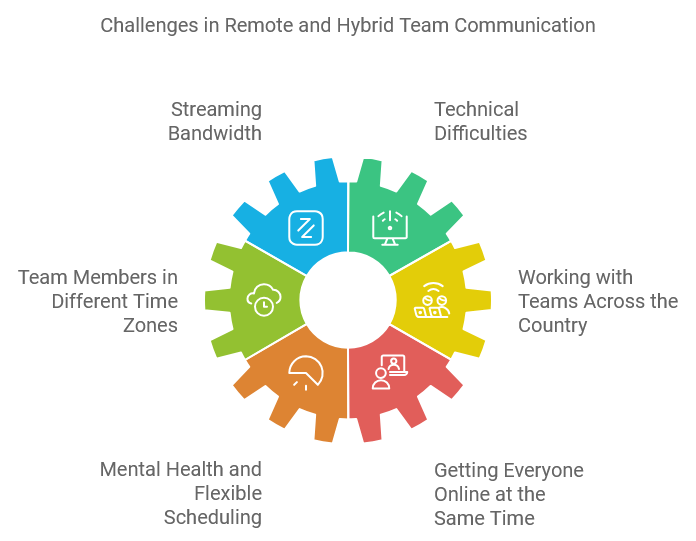
Modern remote and hybrid teams face a far more complex workflow – and need for communication – than in any previous era. For centuries, synchronous communication was considered ideal for productivity. It has been assumed that people working together in the same place at the same time can, in theory, get more done. Surely, this was true when the alternative was letters and even telegraph messages. However, times have more than changed.
Remote and hybrid teams need a unique combination of both synchronous and asynchronous communication. Staying in touch and sharing projects has become complex beyond what any teams before now could imagine. Obstacles to staying in touch include:
- Streaming bandwidth
- Technical difficulties
- Team members in different time zones
- Working with teams across the country
- Mental health and flexible scheduling
- Getting everyone online at the same time
Gathering the entire team for a synchronous morning meeting through Zoom, G-Meet, or other platforms not only requires across-team scheduling. It also requires everyone to have a strong internet connection, a working webcam, and an understanding of the software.
Teams are also no longer limited to those who live nearby. People who live just a state or two away might be in another time zone or even working a completely different shift. However, asynchronous communication is seeing its day in the sun. Teams are achieving greater productivity by not holding meetings or interrupting one another and instead sending well-researched and complete requests that wait to be addressed and completed.
What are Asynchronous and Synchronous Communication?
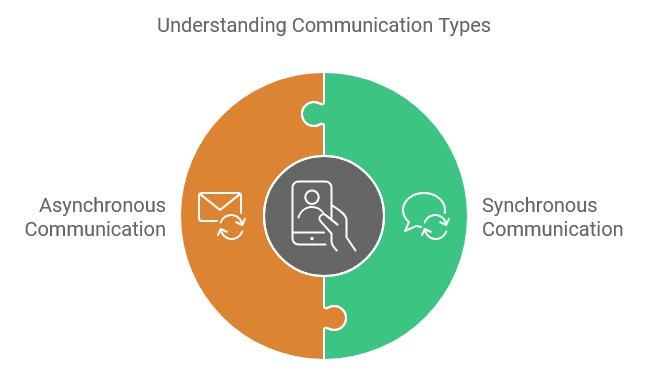
Let’s break down the terminology being used around hybrid and remote communication: synchronous vs asynchronous communication.
Synchronous Communication
Synchronous communication is when you are in sync with another person or people. In other words, a live meeting, a phone call, or an active chat session. Most businesses function on the assumption that synchronous is productive.
People who respond right away are seen as on-the-ball, but without considering what might have been interrupted to answer the message. Live meetings, while seen as more productive, are also a known productivity sink if not conducted quickly with an itinerary and prepared materials.
Asynchronous Communication
Asynchronous communication is when you have a conversation or work on a project while not in sync. Asynchronous is when you send a message and that message waits until it is read. Then you receive an answer when the person on the other side has seen your question and has prepared an answer for you.
Sometimes, asynchronous messages are used to initiate synchronous communication (ex: “Hey, are you available to talk?”) but more often as the remote workforce develops, asynchronous communication is used to trade more complete and prepared questions and answers to those questions.
Examples of Asynchronous Communication
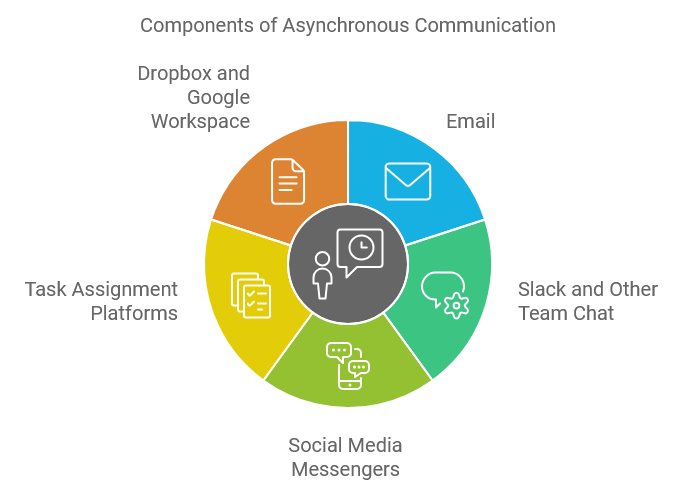
What does asynchronous communication look like?
The first type in history was the letter, sent on paper and read, perhaps after months of travel between being written, read, and then answered in return. E-mail brought us to digital asynchronous communication, which then evolved into “Instant Messaging” or “IMs” or live chat, as the kids call it today – a hybrid of asynchronous messaging with an emphasis on synchronous capabilities.
- Slack and Other Team Chat
- Social Media Messengers
- Task Assignment Platforms
- Dropbox and Google Workspace
From live chat, we saw the evolution of many messenger systems from social media to Slack – all capable of asynchronous but, like email, often treated as if immediate answers are necessary. The most recent developments in asynchronous communication include task management platforms and collaboration document managers like Dropbox and Google Workspace where team members can leave documents and comments for others to see when they next log in.
The Pros and Cons of Asynchronous Communication
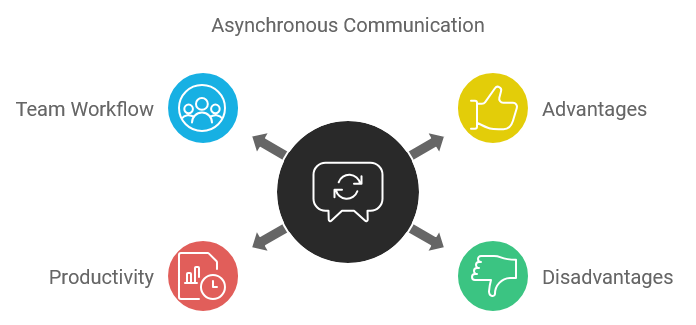
Pros of Asynchronous Communication
- Fewer Interruptions
- Messages Wait to be Answered
- Thoughtful Questions and Responses
- Freedom to Focus at Optimum Productivity
- Time-Zone Friendly
Cons of Asynchronous Communication
- Messages can be Missed
- Playing “Phone Tag”
- Information-Related Delays
- Unresponsive coworkers
The Pros and Cons of Synchronous Communication
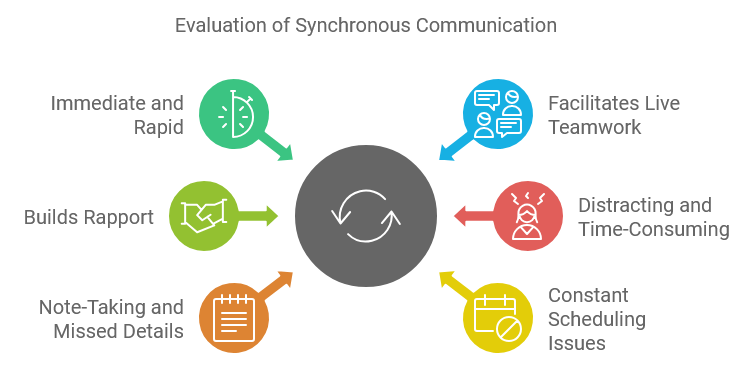
Pros of Synchronous Communication
- Immediate and Rapid
- Facilitates Live Teamwork
- Builds Rapport
Synchronous communication “pros” are well known in the business world. Collaboration, rapid conversations, and live teamwork are rewards unto themselves. Live communication may also promote rapport between team members.
Cons of Synchronous Communication
- Distracting and Time-Consuming
- Note-Taking and Missed Details
- Constant Scheduling Issues
- Not Time-Zone Friendly
However, the “cons” of synchronous communication we are just now able to discuss without workplace reprisal. Many professionals have found their daily meetings to be more time-consuming than saving, with information lost any time notes are incomplete. Then, of course, there is the increasing struggle to keep everyone on the same meeting schedule across a widening schedule and time zone diversity.
Why Asynchronous Communication is Necessary
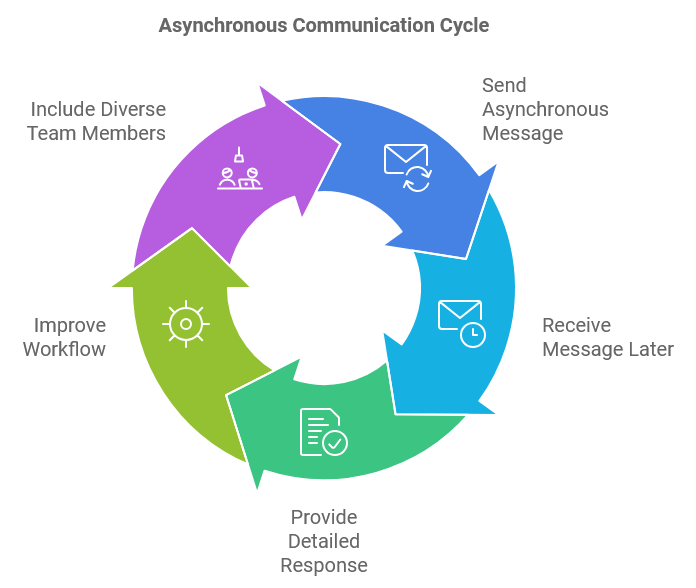
Asynchronous communication has become necessary simply because the synchronous approach can’t cover all bases:
- How do you let a team member in Europe know that you have the assets they asked for?
- How do you ask a question of the night-shift IT manager?
You leave an asynchronous message and – in a healthy async team – you may return to your inbox later to find a complete and well-formed response.
Team members across the world, across schedules, and with different communication styles need asynchronous communication to close the gap. It is no longer possible to require 100% of a diverse team to be present and available for every live meeting, or to answer emailed questions within five minutes of receiving the message. In fact, we could say the latter was never truly reasonable.
Teams today not only need asynchronous communication, they also choose it. Team members who could book a video chat instead choose to send complete and well-formed questions and answers in the form of reports and shared documents – creating a more productive workflow that is also highly inclusive of differently scheduled coworkers.
Benefits of Asynchronous Communication
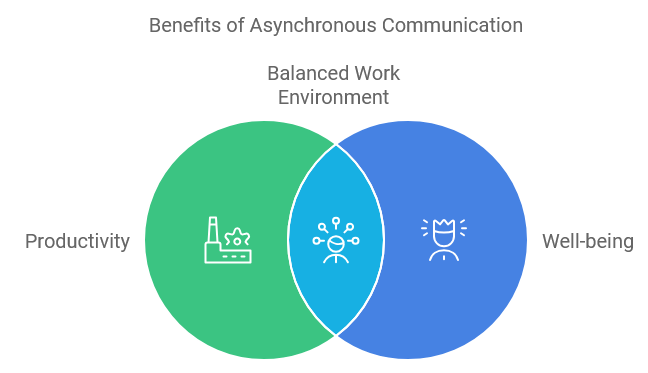
Improve Productivity Without Interruptions
For most professionals, the single greatest benefit of adopting asynchronous communication is the freedom to focus. We know that good work and the application of complex skills require focus, and focus requires uninterrupted time.
Having a co-worker pop into your office or into your inbox every few minutes is hardly conducive to focused productivity. However, in a team where messages can wait until inboxes are checked (perhaps two or three times a day) is one where every team member can choose their focus-hours and really get their best work done without stopping to answer unrelated questions in the middle of their session.
Autonomy, Agency, and Empowerment
Asynchronous communication also removes the weight of micro-management – even if managers are still attentive and inquisitive. It’s frustrating to stop and check in every few minutes, and can remove your talented team’s sense of agency, autonomy, and empowerment when they have no choice but to initiate a live conversation in the middle of their focus time.
Asynchronous communication allows professionals to regain that sense of autonomy and empowerment by controlling when they answer and the thoroughness with which they address every task and question.
Inclusive Accessibility
Managers often first notice that asynchronous communication is more productive in a diverse team. It is both more accessible for people in different time zones and also more accessible for those with varying personal and medical limitations. Those working across the globe can answer emails during their morning coffee – instead of in the middle of their night.
Remote employees with orthopedic concerns can answer questions even if they can’t handle a video call, while those with anxiety might work best with asynchronous communication to avoid the stress of a live conversation.
Reduces Stress and Burnout
Asynchronous communication – as you might guess – can also help reduce stress and burnout, and increase team-wide mental wellness. By increasing autonomy and agency and reducing the demand to answer immediately, many people – for their own reasons – will experience less stress during the work week and flexibility to avoid new stress until they are ready – thus tackling the issue of burnout.
Promotes Careful and Organized Responses
Last but never least, asynchronous communication promotes thoughtful and complete questions and responses. When asking a question someone may answer hours from now, you tend to formulate it more completely so the other person can answer when you may not be online. This leads to well-framed questions, shared documents and reference material, and answers that are just as carefully completed.
In fact, this type of asynchronous communication easily becomes project collaboration as each person completes a piece and then checks in with their team or partner. In this way, asynchronous communication can be even more productive than a live chat, video, or in-person meeting.
How to Improve Asynchronous Communication on Your Team
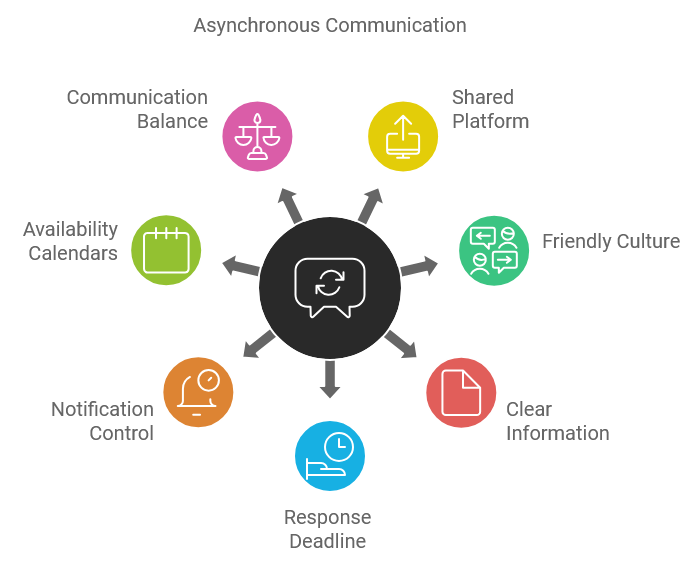
- Give your team a shared asynchronous platform
- Create a culture of friendly synced and async communication
- Provide enough information for the other person to fully respond, including resources
- Set a deadline – when you need a response by
- Take control of notifications to clarify online, offline, and busy availability
- Share availability calendars
- Balance Synchronous and asynchronous communication methods
Achieving Balance Between Synchronous and Asynchronous Communication
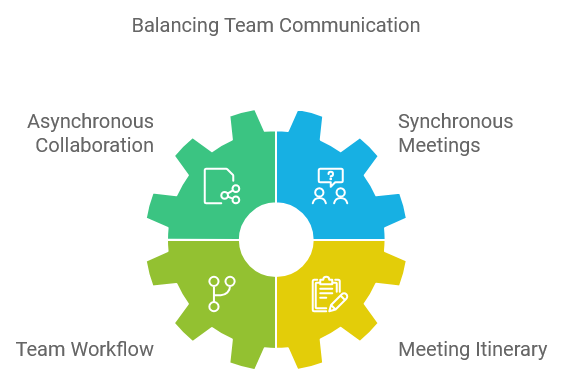
How can teams achieve a balance between synchronous and asynchronous communication? The first step is to let your team work some of this out for themselves.
As professionals, building a personal and team workflow is part of the job, and as we sail into new waters in terms of software and collaboration possibilities, today’s teams will forge the standards for future projects. When you have a culture of asynchronous collaboration and access to live meeting tools, team members will typically determine which tasks and discussions are best done by trading documents and notes versus a quick live chat.
When you do book a meeting, especially with more than two people, always have an itinerary and share it before or as the meeting starts. This blends the value of synchronous communication with what we’ve learned about asynchronous productivity.
Create an Asynchronous Workflow with Real-Time Tracking

How can you create an asynchronous company culture without sacrificing the real-time oversight of live meetings and immediate email responses?
Tools like HiveDesk make it possible for managers to monitor remote team’s activities and productivity without interrupting their workflow. Why stop your employee from their head-down work session when you can simply check a screenshot to see what they’re working on?
HiveDesk makes it possible to monitor your team without micro-managing, to achieve synchronous management, while allowing your team the freedom of asynchronous focus. Start your free trial to discover the possibilities of synchronous and asynchronous HiveDesk solutions for your team.
